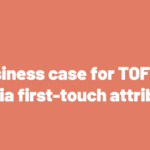As Google phases out third-party cookies, the marketing world is making a big pivot. If the data won’t go to the marketer, the marketer must find a way to go to the data. Privacy regulations like GDPR and CCPA mean we’ve got to get smarter about how we track, target, personalize, and measure our marketing efforts.
In a world where marketers are increasingly losing visibility, first-party data is now more important than ever. Companies have to be able to understand it, put more emphasis on it, and figure out how to collect it efficiently.
To get started, here are three reasons why first-party data is now crucial:
1. Enhanced Personalization and Targeting:
Now that third-party cookies are being deprecated, the personalization and targeting that first-party data provides will be foundational to marketers looking to get insights into consumer behavior, preferences, and interests – and coming straight from the source.
And we’re not talking about addressing the customer by name in your weekly newsletter and calling it personalized. It’s about actually understanding the customer’s journey with your brand—what they’ve viewed, purchased, or interacted with—without relying on tracking people across the Internet.
Also, first-party data can help you create customer segments based on specific criteria (purchase history, website engagement, geographic location…) and tailor your marketing to what will resonate the most with them.
For example, if you see a customer frequently purchasing product XYZ, you can target them with related products or offer them a promotion on their next purchase. Then you can move them to a segment of customers that fit the same profile and market to them as a group in the future.
2. Trust and Privacy Compliance:
Privacy regulations are driving Google’s move with cookies and continue to make marketers lose visibility. The only insights and information we can get on our customers now has to come from first-party data – which its collection is privacy-compliant because it involves a direct relationship between the business and the customer.
This makes sure that companies are better positioned to comply with stringent data protection regulations like GDPR in Europe and CCPA in California where explicit consent from users before collecting their personal information is required.
Ideally, you won’t only be compliant but you’ll build trust with your customers by transparently communicating how customer data will be used to enhance their experience and by giving customers control over their personal information. The more trust you can generate, the more first-party data you’ll get back from them.
3. Improved Measurement and Attribution:
First-party data won’t be your marketing measurement holy grail (nothing will!) but it can help you link your marketing activities to consumer behaviors and conversions and get a different perspective on the conversion paths in your customers’ journey.
The classic example here is the “How did you hear about us” field that is integrated into surveys and sign-up or purchase forms. This shows the pros and the limitations of using first-party data as a measurement tool:
It’s great for:
- Collecting nuanced feedback directly from customers about the channels through which they discovered your brand.
- Streamlining the data collection process for marketing attribution. It’s a cheap and quick but valuable data point.
It’s limited because:
- The accuracy of responses may be compromised by recall bias, where customers might not accurately remember the channel that led them to you.
- It doesn’t fully capture the multi-channel journey that might have contributed to a purchase.
- It’s qualitative data so it can be time-consuming to categorize and may not always lead to clear actionable insights.
As third-party cookies become obsolete, the emphasis on first-party data for measurement will naturally increase. Add it to your triangulation but don’t trust it blindly – don’t trust any measurement method blindly, actually.
5 Effective Methods for Collecting First-Party Data
First-party data is now more important than ever – we’re clear on that. So, how can organizations go about collecting it?
There are five common methods:
- Website Analytics: Using data from user interactions on a brand’s website, like page views and session durations, to understand visitor behavior and preferences. A great example of this is Amazon. If a person buys the products, puts it in the cart or even just takes a look at it – they will use that data to recommend that same product or similar ones to them when they return to the shop.
- CRM Systems: Using them to aggregate data from customer interactions, purchases, and communications and to get a more comprehensive customer journey view. A use case of this is Apple – they offer personalized customer experiences by using Apple ID to remember music and film selections and to provide personalized recommendations across devices.
- Subscription Forms: Gathering information directly from users when they sign up for your newsletter, webinar, or when they download content. Look at Shutterfly for this, they use subscription forms for personalized product suggestions.
- Customer Surveys and Feedback: Collecting direct feedback through surveys, polls, and feedback forms to gain insights into customer preferences, experiences, and expectations. A good example of this is Penguin Random House and their quizzes that match you with books you might love.
- Loyalty Programs: Reward customer engagement and purchases with points, discounts, and other benefits to “earn” your customers to share their personal information and preferences. Tesco’s Clubcard is a prime example and their loyalty program not only collects valuable customer data but incentivizes repeat business.


